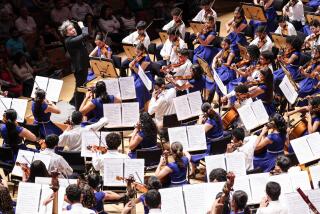The Best of 2 Worlds : Composer James DeMars seeks to blend American Indian sound, which stresses nature, with traditional European symphony
The title began as a pun. If Dvorak could write the “New World” Symphony, James DeMars figured, why couldn’t he write the “Two World” Symphony? The name seemed appropriate enough for a work based on European models that incorporates American Indian themes.
He followed up that offbeat orchestral piece with another, the “Two World” Overture. This afternoon, DeMars’ latest work, the “Two World” Concerto, makes its Los Angeles debut when the Phoenix Symphony performs at UCLA’s Royce Hall. R. Carlos Nakai, the American Indian flutist for whom the work was written, will be the soloist.
For DeMars, a Phoenix-based composer of French-Canadian ancestry, the recurring title primarily refers to his propensity to include sounds of other cultures in his work. His previous “two world” works have included Arabic and African sounds, as well as American Indian music.
But the title’s multiple meanings embrace metaphysics as well as music. American Indian music, he noted, often contains evocations of two worlds--the world in which we live, and the spirit world. What’s more, it also moves easily between the world of man and the world of nature.
“For a moment, you might think you hear a coyote,” he said of the American Indian choral pieces he listened to before writing his concerto. “You hear birds all the time. It’s very interesting music that incorporates the sounds of the wilderness.”
DeMars hopes to capture some of that in his concerto, which premiered in Phoenix earlier this month. Commissioned by the Arizona-based Flinn Foundation as part of a cooperative project between the Heard Museum in Phoenix and the Phoenix Symphony, it is a classically structured, three-movement work that does not incorporate traditional chants, but does include an original song written by soloist Nakai.
DeMars said the American Indian flute, or cedar flute, “is very close to a recorder,” with two important differences: There are fewer finger holes, and they are not placed in the exact spots that would allow the flute to replicate a standard European scale.
“Each tone hole was placed where the fingers (of the original craftsman) fell,” DeMars said. “So there wasn’t a specific tuning. There are only two notes on the instrument that match the standard, tempered tuning.”
Needless to say, the resultant inability to tune the instrument with the orchestra posed significant problems to the composer.
“I had some horrible moments as I learned (how to handle) this,” DeMars said. One trick he devised was to build into the work “points of coordination where the orchestra and soloist can get back together in the event they inadvertently drift apart.”
“Carlos has the orchestral line written into his part,” DeMars said. “He’s following that. If he has to link up with an orchestral instrument and play in unison, he will. At other times, he’ll play very freely.”
“Jim was able to grasp the concept of the arbitrary system of tuning and performance technique, and then utilize that,” Nakai said. “This piece won’t work for any other Native American flute in the world, except for the two we’re using.”
Those two flutes are exact replicas of 19th-Century Navajo instruments, added Nakai, a Flagstaff native who traces his ancestry to the Ute, Navajo and Zuri people.
Another thing DeMars learned during the compositional process is that the flute doesn’t sound its best “marching in lock-step with the orchestra.” He said the instrument can be played in a strict rhythm, but noted that it was designed to be played much more freely. Asking it to do otherwise “breaks radically with tradition,” he said. “It loses something.”
DeMars himself made a radical break with tradition when he moved to Phoenix from his native Minnesota in 1981. The composer, now 40, started writing music in sixth grade, and tended to create pieces that reflected his “avant-garde roots.”
“I played a lot of Stockhausen and Crumb when I was younger,” said DeMars, who received his doctorate in composition from the University of Minnesota. Among his teachers was Dominick Argento.
After his move to Arizona State University, however, he found “influences of other cultures seeping into my compositions.” He founded an ensemble called Tos that included an African-American percussionist and, eventually, Nakai. His works, as performed by the ensemble, are featured on the compact disc “Spirit Horses,” which was nominated for a Grammy Award in 1992.
DeMars, who has also incorporated Arabic sounds into his works, is working on a Requiem Mass commemorating the 30th anniversary of John F. Kennedy’s death. It, too, contains sounds of other cultures, but he insists that--like his previous works--it is nevertheless written in his voice.
“Your own ideas come through, no matter what influences make their way into your music,” he said. “You solve things in your own way.”
Besides, he said, he has no use for “ego-oriented” music.
“I look for that sense of ‘it feels right,’ ” he said. “That’s what I like about Mozart. I aspire to his elegance, where there’s a sense of inevitability. Each phrase has its own expectations; if you’re intuitive, you can understand that and then write the next phrase.
“I want people to enjoy listening to what I write,” he added. “But I have no desire to make people aware of me.”
The Phoenix Symphony, conducted by music director James Sedares, will perform at 3 p.m. today at Royce Hall on the UCLA campus. The program also includes Mozart’s Symphony No. 33 and Saint-Saens’ Symphony No. 3, with organist Cherry Rhodes. Tickets: $14-$25. Call (310) 825-2101.
More to Read
The biggest entertainment stories
Get our big stories about Hollywood, film, television, music, arts, culture and more right in your inbox as soon as they publish.
You may occasionally receive promotional content from the Los Angeles Times.










